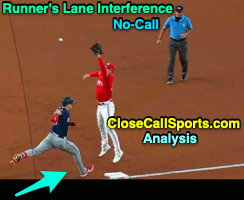As Crew Chief Tom Hallion ruled runner Kevin Kiermaier out following a Replay Review in Tampa Bay after a collision with Red Sox fielder Enrique Hernandez, resulting in 2B Umpire Mark Ripperger's interference no-call, Boston manager Alex Cora emerged to seek an explanation for the decision, appearing satisfied with the outcome.
The question we were asked is why was Kiermaier not ruled out for interference after appearing to knock the baseball out of Hernandez's glove during a tag attempt.
To guide us through Rule 6.01(a) regarding interference, we turn directly to the MLB Umpire Manual, which states, "While contact may occur between a fielder and runner during a tag attempt, a runner is not allowed to use his hands or arms to commit an obviously malicious or unsportsmanlike act—such as grabbing, tackling, intentionally slapping at the baseball, punching, kicking, flagrantly using his arms or forearms, etc.—to commit an intentional act of interference unrelated to running the bases. Further, if in the judgment of the umpire such intentional act was to prevent a double play, the umpire would rule the batter-runner out as well."
The MLBUM interp starts with a very key phrase—"contact may occur between a fielder and runner during a tag attempt"—and continues with the bread and butter of this rule: "obviously malicious and unsportsmanlike act."
Gil's Call: Whether malicious, unsportsmanlike, intentional, or willful/deliberate, all of these acts describe a similar non-baseball play. In order to determine whether such malfeasance occurred, I generally look for three elements, borrowed from basketball. Your mileage may vary.
Windup: Did the potential offender indicate a pre-contact intent or premeditation to commit such an act?
Impact: Did contact actually occur or, in the absence of contact, was the defense actually impeded?
Follow-Through: Did the offensive player complete the illegal act, even after contact terminated?
For the Kiermaier play, much is made about the runner's right elbow or "chicken wing" in the aftermath of contact with Hernandez, but I see this as a reaction to his contact with Hernandez. Sure, there may have been a moment
during the contact in which Kiermaier threw his arm upward, but I don't see the requisite pre-contact preparatory act that would otherwise suggest an intentional and
obviously malicious act.
I compare and contrast this play with Yankees batter-runner Alex Rodriguez's interaction with Red Sox pitcher Bronson Arroyo during a tag attempt in Game 6 of the 2004 American League Championship Series, originally no-called by 1B Umpire Randy Marsh and eventually reversed to interference after crew consultation with, amongst others, the umpire most likely to have seen the offending act, HP Umpire Joe West.
In the A-Rod scenario, the offending player
clearly and
obviously winds up with his left arm, turns his head to look at the fielder, swings downward at Arroyo's glove, and intentionally slaps the ball out of the glove with his hand, following through with his arm swing.
Thus, Kiermaier's after-the-fact elbow, for me, isn't adequate to suggest what may have happened before. In my estimation, this ex post facto event is inadmissible relative to what occurred prior to the dropped ball when Kiermaier and Hernandez made legally permissable contact as Kiermaier ran from first to second base after Hernandez had already fielded the batted ball and had moved on to a tag attempt.
In my estimation (as well as, apparently, 2B Umpire Ripperger's estimation, as well), if the rule/interpretation seeks something to be obvious, a 50-50 call likely will err on the side of the alleged misconduct having not occurred, for lack of it being obvious.
What does "obviously malicious" mean to you? Video as follows:





























